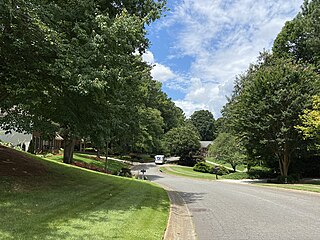Related Research Articles

Cobb County is a county in the U.S. state of Georgia, located in the Atlanta metropolitan area in the north central portion of the state. As of 2020 Census, the population was 766,149. It is the state's third most populous county, after Fulton and Gwinnett counties. Its county seat is Marietta; its largest city is Mableton.

Cherokee County is located in the US state of Georgia. As of the 2020 Census, the population was 266,620. The county seat is Canton. The county Board of Commissioners is the governing body, with members elected to office. Cherokee County is included in the Atlanta Metropolitan Area.

Acworth is a city in Cobb County, Georgia, United States. It is part of the Atlanta metropolitan area. As of the 2020 census, this city had a population of 22,440, up from 20,425 in 2010. Acworth is located in the foothills of the North Georgia mountains along the southeastern banks of Lake Acworth and Lake Allatoona on the Etowah River. Unincorporated areas known as Acworth extend into Bartow, Cherokee and Paulding counties.

Kennesaw is a suburban city northwest of Atlanta in Cobb County, Georgia, United States, located within the greater Atlanta metropolitan area. Known from its original settlement in the 1830s until 1887 as Big Shanty, it became Kennesaw under its 1887 charter. According to the 2020 census, Kennesaw had a population of 33,036, a 10.9% increase in population over the preceding decade. Kennesaw has an important place in railroad history. During the Civil War, Kennesaw was the staging ground for the Great Locomotive Chase on April 12, 1862.

Mableton is a city in Cobb County, Georgia, United States. Voters of the unincorporated area of Mableton approved a referendum to incorporate on November 8, 2022, and six council members were elected on March 21, 2023, with Michael Owens elected as Mayor in a runoff on April 21, 2023. According to the 2020 census, Mableton has a population of 78,000. Upon Brookhaven's cityhood in December 2012, Mableton was previously the largest unincorporated CDP in Metro Atlanta. With boundaries described in Appendix A of House Bill 839, Mableton is set to become the largest city in Cobb County in terms of population, and will include historical Mableton, along with the Six Flags area, areas of unincorporated Smyrna, and other residents of unincorporated South Cobb. While 53% of voters approved the referendum, many residents are already exploring deannexation.

Marietta is a city in and the county seat of Cobb County, Georgia, United States. At the 2020 census, the city had a population of 60,972. The 2019 estimate was 60,867, making it one of Atlanta's largest suburbs. Marietta is the fourth largest of the principal cities by population of the Atlanta metropolitan area.
The Georgia Northeastern Railroad is a short line freight railroad which runs from the town of Elizabeth, Georgia to the city of Blue Ridge, Georgia. Goods hauled are mostly timber, grain, poultry, and marble products. The GNRR's subsidiary, the Blue Ridge Scenic Railway, also operates on this line north of Blue Ridge. Despite the name, it actually operates between north-central and northwest Georgia, from north-northwest metro Atlanta, and is a few counties away from northeast Georgia.

The Cobb County Public Library System (CCPLS) is a system of 16 public libraries in Cobb County, Georgia, United States, excluding its second-largest city of Smyrna, which runs its own Smyrna Public Library. CobbCat.org is the online database of all CCPLS holdings.

Sweat Mountain is a mountain in far northeastern Cobb County, Georgia, in the suburbs north of Atlanta. The exact GNIS location of its summit is 34°4′1″N84°27′20″W, and it has an official (USGS) elevation of 1,688 ft (515 m) above mean sea level. It is the second-highest point in the county behind Kennesaw Mountain, and second in the core metro Atlanta area, behind Kennesaw Mountain, which is also in Cobb County. It is fifth if the exurban counties further north are considered.

Noonday Creek is a 20.2-mile-long (32.5 km) stream in Cobb and Cherokee counties in the U.S. state of Georgia. The stream begins near Kennesaw Mountain and ends at Lake Allatoona.
There were several historic mills around the metro Atlanta area, for which many of its current-day roads are still named. Most of the mills date back to the 1820s and 1830s, and were built along the area's many streams. The locations of many of these mills are shown on a map of 1875 showing U. S. military operations around Atlanta in 1864. This map is now located in the U. S. Library of Congress but can be seen on the webpage linked here.

Ernest W. Barrett Parkway is a major thoroughfare in the northwestern part of the Atlanta metropolitan area, in the north-central part of Cobb County, in the U.S. state of Georgia. It travels from the southeastern edge of Kennesaw to a point north of Marietta, and continues on in both directions under other names. The portion of Barrett Parkway between Interstate 575 (I-575/SR 5) and US 41/SR 3 is designated State Route 5 Connector. The road is named after Ernest W. Barrett, the first chairman of the Cobb County Board of Commissioners in the 1960s, after home rule was enacted under a Georgia State Constitution amendment. The initial portion was constructed through Barrett family land, enabling it to be later sold for major development.

State Route 5 (SR 5) is a 155.325-mile-long (249.971 km) state highway that travels south-to-north through portions of Carroll, Douglas, Cobb, Cherokee, Pickens, Gilmer, and Fannin counties in the western and northern parts of the U.S. state of Georgia. The highway travels from its southern terminus at SR 48 at the Alabama state line, north-northwest of Ephesus, to its northern terminus at SR 60 and SR 68 at the Tennessee state line on the McCaysville–Copperhill line, bisecting the northwestern portion of the state.
Chattahoochee Technical College is a public technical college in the U.S. state of Georgia. It is governed by the Technical College System of Georgia and has eight campuses in the north-northwest metro-Atlanta area, and another just outside the region. It is accredited by the Southern Association of Colleges and Schools Commission on Colleges (SACS) to award technical certificates of credit, diplomas, and associate degrees. The college was formed in 2009 as the result of the merger of Appalachian Technical College, Chattahoochee Technical College, and North Metro Technical College.

The Gilmer County Courthouse was the courthouse for Gilmer County, Georgia, United States, from 1934 until 2003. It was built in 1898 as the Hyatt Hotel, making it the only courthouse in the state not originally built as a courthouse. It was listed on the National Register of Historic Places in 1980.
The Noonday Water Reclamation Facility is a sewage treatment plant that processes around 20 million gallons or 75 million liters of sewage per day for northeast Cobb and southern Cherokee counties in north-northwest metro Atlanta, located in north-central Georgia. It is operated by Cobb's water system, which partly wholesales its service to Cherokee's.

Woodstock is a town in Ulster County, New York, United States, in the northern part of the county, northwest of Kingston. It lies within the borders of the Catskill Park. The population was 6,287 at the 2020 census, up from 5,884 in 2010.
The Sequoyah Regional Library System (SRLS) is a library system serving three counties in North Georgia: Cherokee, Pickens, and Gilmer. Funding is provided by the cities and counties in Cherokee and Pickens, and by the board of education in Gilmer.

Johnston's River Line, also called Johnston's Line, the Chattahoochee River Line or simply The River Line, is a historic American Civil War defensive line located in the communities of Mableton, Smyrna, and Vinings, Georgia that was used by the Confederate Army under General Joseph E. Johnston during the Atlanta Campaign in early July 1864. While no significant battles took place along the River Line, it remains one of the most impressive defensive fortifications ever constructed, often compared to the French Maginot Line built prior to World War II. Part of the River Line Historic Area and the Chattahoochee River Line Battlefield, the site today consists of the remains of Confederate earthwork battlements including unique fortifications called Shoupades, named after their designer, Confederate Brig. General Francis A. Shoup. The remains are spread across a six to seven mile stretch along the northwest side of the Chattahoochee River from a point just north of where Nickajack Creek joins the Chattahoochee in Mableton to north of S. Atlanta Road in Smyrna/Vinings. It was added to the National Register of Historic Places on July 5, 1973. Although many of the remains are on private property, visitors can access the site off U.S. 78 in Mableton, and off S.R. 280 and S. Atlanta Rd in Smyrna/Vinings. The site's coordinates are 33°47′31″N84°31′23″W.
thumb The ruins of Union Chapel, also known as Nesbitt Union Chapel, are situated on Powder Springs Street between Marietta and Powder Springs, in Marietta, Georgia. The original chapel consisted of a single room, with a stony façade and Gothic-style arched windows and door. The building had deteriorated significantly by the 1940s, becoming unsafe for use. By the early 21st Century only a corner of the original has remained standing. The Nesbitt/Union Chapel played a significant role in the religious, social, and agricultural history of Cobb County, in addition to its association with several of the County's prominent, early families. Currently, the Chapel ruins are barely visible from the road, obscured by trees and heavy underbrush. The ruins of the Nesbitt Union Chapel, constructed of rammed earth in the Gothic Revival style, are architecturally significant for the unusual material and a style uncommon in religious architecture in rural Georgia.
References
- ↑ "Northwest Georgia Threatened Historic Sites Project". 27 September 2007. Archived from the original on 2007-09-27. Retrieved 2 April 2019.
- ↑ Lands, LeeAnn (February 8, 2006). "Rome's DeSoto Theater Identified as Threatened Historic Site - News | KSU". news.kennesaw.edu. Retrieved 2 April 2019.